The planets in our solar Study guides, Class notes & Summaries
Looking for the best study guides, study notes and summaries about The planets in our solar? On this page you'll find 407 study documents about The planets in our solar.
Page 4 out of 407 results
Sort by
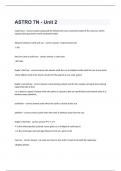
-
ASTRO 7N - Unit 2 Question and answers rated A+ 2024
- Exam (elaborations) • 14 pages • 2024
-
Available in package deal
-
- $12.99
- + learn more
ASTRO 7N - Unit 2 Question and answers rated A+ 2024 ASTRO 7N - Unit 2 Copernicus - correct answer proposed the heliocentric (sun-centered) model of the universe, which replaced the geocentric (earth-centered) model distance between earth and sun - correct answer 1 astronomical unit -1 AU time for earth to orbit sun - correct answer 1 earth year -365 days Kepler's first law - correct answer the planets orbit the sun in elliptical orbits with the sun at one focus -these ellipses ...
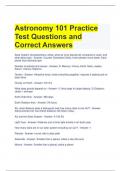
-
Astronomy 101 Practice Test Questions and Correct Answers
- Exam (elaborations) • 21 pages • 2023
-
Available in package deal
-
- $12.49
- + learn more
Astronomy 101 Practice Test Questions and Correct Answers Solar System Characteristics: orbits, what do inner planets do compared to outer, and what about spin - Answer- Counter Clockwise Orbits, Inner planets move faster, Each planet has individual spin Number of planets and names - Answer- 8: Mercury, Venus, Earth, Mars, Jupiter, Saturn, Uranus, Neptune Gravity - Answer- Attractive force, holds everything together, requires 2 objects pull on each other Gravity on Earth - Answer- 9.8...
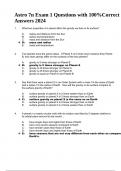
-
Astro 7n Exam 1 Questions with 100%Correct Answers 2024.
- Exam (elaborations) • 14 pages • 2024
- Available in package deal
-
- $12.99
- + learn more
Astro 7n Exam 1 Questions with 100%Correct Answers 2024. 1. What two properties of a planet affect the gravity we feel on its surface? A: radius and distance from the Sun B: radius and temperature C: mass and distance from the Sun D: mass and radius E: mass and temperature 2. Two planets have the same radius. If Planet A is 5 times more massive than Planet B, how does gravity differ on the surfaces of the two planets? A: gravity is 5 times stronger on Planet B B: gravity is 5 times...

-
ST 235-01 UNCG Final Exam Study Guide Questions and Answers with complete solution
- Exam (elaborations) • 16 pages • 2024
- Available in package deal
-
- $9.69
- + learn more
The cosmic calendar - a imaginary concept to examine the history of our planet compressed into one year-Carl Sagan, human civilzation doesn't come on the scene until almost the last few seconds. This made people realize how insignificant human society is on the grand scale of time and the imense universe especially in the human-centerd view of religions. planet - A large body in space that orbits a star and does not produce light of its own star - A ball of hot gas, primarily hydrogen and...
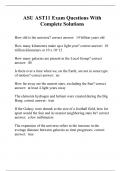
-
ASU AST11 Exam Questions With Complete Solutions
- Exam (elaborations) • 21 pages • 2023
-
- $12.99
- + learn more
How old is the universe? correct answer: 14 billion years old How many kilometers make up a light year? correct answer: 10 trillion kilometers or 10 x 10^12 How many galaxies are present in the Local Group? correct answer: 40 Is there ever a time when we, on the Earth, are not in some type of motion? correct answer: no How far away are the nearest stars, excluding the Sun? correct answer: at least 4 light years away The elements hydrogen and helium were created during the Big...
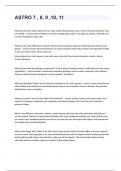
-
ASTRO 7 , 8, 9 ,10, 11 questions with answers 2024
- Exam (elaborations) • 7 pages • 2024
-
- $12.99
- + learn more
ASTRO 7 , 8, 9 ,10, 11What are the four major features of our solar system that provide clues to how it formed? Describe each one briefly. - correct answer Patterns of motion among large bodies, Two types of planets, asteroids and comets, exceptions to the rules. What are the basic differences between the terrestrial and jovian planets? Which planets fall into each group? - correct answer Terrestrial planets are small and dense with rocky surfaces and abundant metals in the core: Earth, Mars,...
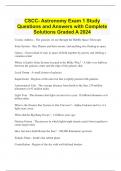
-
CSCC- Astronomy Exam 1 Study Questions and Answers with Complete Solutions Graded A 2024
- Exam (elaborations) • 15 pages • 2024
-
- $14.99
- + learn more
Cosmic Address - The galaxies we see through the Hubble Space Telescope Solar System - Sun, Planets and their moons, and anything else floating in space Galaxy - Great island of stars in space all held together by gravity and orbiting a common center Where is Earth's Solar System Located in the Milky Way? - A little over halfway between the galactic center and the edge of the galactic disk Local Group - A small cluster of galaxies Supercluster - Regions of the universe that is ti...

-
(ASU) AST 111 Exam 3 || with Errorless Solutions 100%.
- Exam (elaborations) • 9 pages • 2024
-
Available in package deal
-
- $11.29
- + learn more
Io experiences tidal heating primarily because __________. correct answers Io's elliptical orbit causes the tidal force on Io to vary as it orbits Jupiter. As you learned in Part A, Io's elliptical orbit is necessary to its tidal heating. This elliptical orbit, in turn, is a result of the orbital resonance among Io, Europa, and Ganymede. This orbital resonance causes Io to have a more elliptical orbit than it would otherwise, because __________. correct answers Io periodically passes Europa...
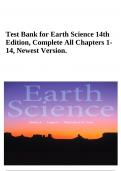
-
Test Bank for Earth Science 14th Edition, By Tarbuck Complete All Chapters 1- 14, Newest Version.
- Exam (elaborations) • 637 pages • 2024
-
- $34.49
- + learn more
Test Bank for Earth Science 14th Edition, Complete All Chapters 1- 14, Newest Version. What are the basic differences between the disciplines of physical and historical geology? A) Physical geology is the study of fossils and sequences of rock strata; historical geology is the study of how rocks and minerals were used in the past. B) Historical geology involves the study of rock strata, fossils, and geologic events, utilizing the geologic time scale as a reference; physical geology includes...
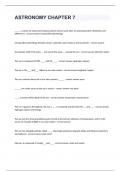
-
ASTRONOMY CHAPTER 7 questions well answered 2024/2025
- Exam (elaborations) • 7 pages • 2024
-
Available in package deal
-
- $12.99
- + learn more
ASTRONOMY CHAPTER 7___ __ is when we study and compare planets next to each other to understand their similarities and differences - correct answer Comparative planetology Comparative planetology includes moons, asteroids, and comets as well as planets - correct answer Our planets orbit it the same __ and nearly the same __ around the sun - correct answer direction; plane The sun is composed of 98% ____ and 2% ____ - correct answer Hydrogen; Helium The sun is the ___ and ___ object ...

Did you know that on average a seller on Stuvia earns $82 per month selling study resources? Hmm, hint, hint. Discover all about earning on Stuvia


